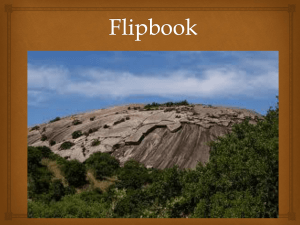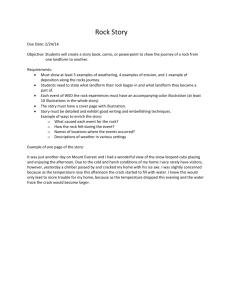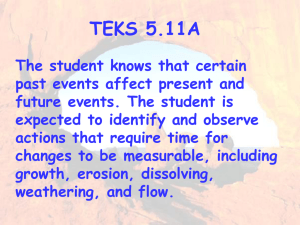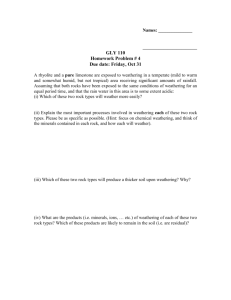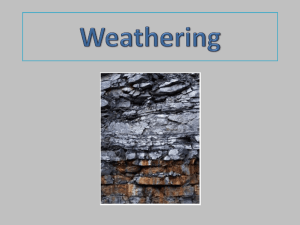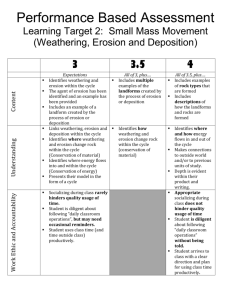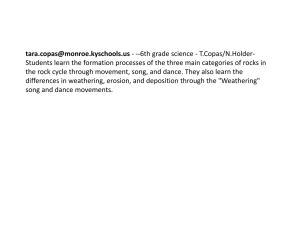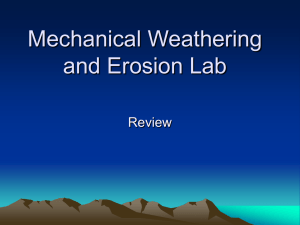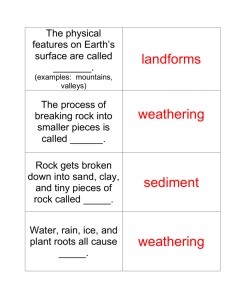science-6-cm
advertisement
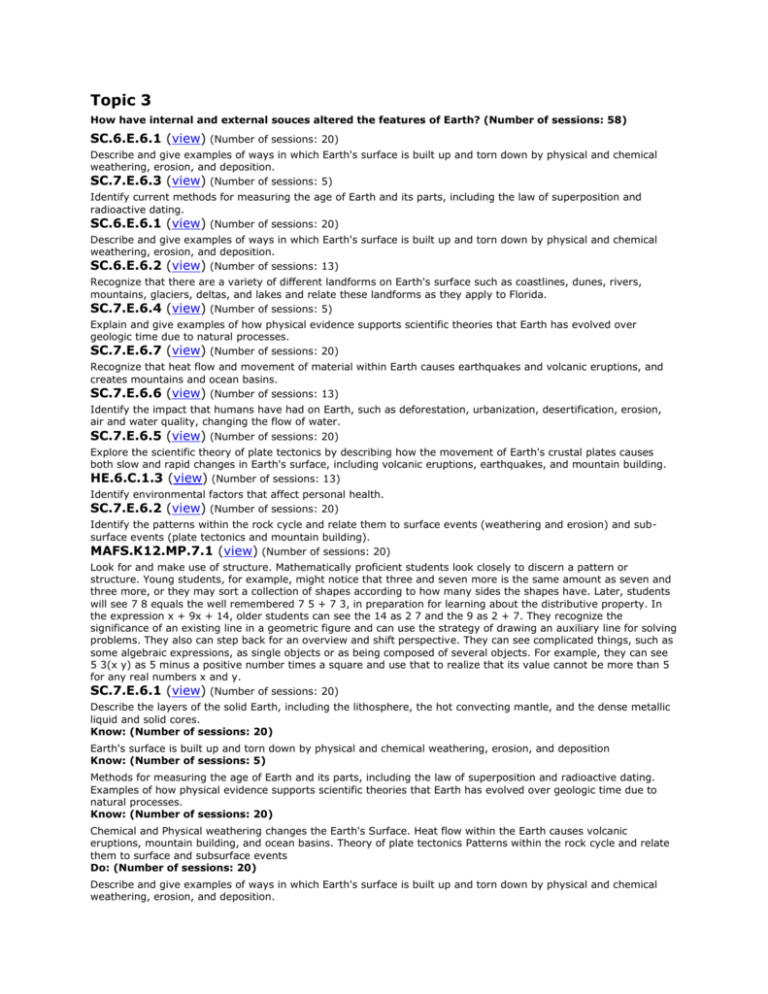
Topic 3 How have internal and external souces altered the features of Earth? (Number of sessions: 58) SC.6.E.6.1 (view) (Number of sessions: 20) Describe and give examples of ways in which Earth's surface is built up and torn down by physical and chemical weathering, erosion, and deposition. SC.7.E.6.3 (view) (Number of sessions: 5) Identify current methods for measuring the age of Earth and its parts, including the law of superposition and radioactive dating. SC.6.E.6.1 (view) (Number of sessions: 20) Describe and give examples of ways in which Earth's surface is built up and torn down by physical and chemical weathering, erosion, and deposition. SC.6.E.6.2 (view) (Number of sessions: 13) Recognize that there are a variety of different landforms on Earth's surface such as coastlines, dunes, rivers, mountains, glaciers, deltas, and lakes and relate these landforms as they apply to Florida. SC.7.E.6.4 (view) (Number of sessions: 5) Explain and give examples of how physical evidence supports scientific theories that Earth has evolved over geologic time due to natural processes. SC.7.E.6.7 (view) (Number of sessions: 20) Recognize that heat flow and movement of material within Earth causes earthquakes and volcanic eruptions, and creates mountains and ocean basins. SC.7.E.6.6 (view) (Number of sessions: 13) Identify the impact that humans have had on Earth, such as deforestation, urbanization, desertification, erosion, air and water quality, changing the flow of water. SC.7.E.6.5 (view) (Number of sessions: 20) Explore the scientific theory of plate tectonics by describing how the movement of Earth's crustal plates causes both slow and rapid changes in Earth's surface, including volcanic eruptions, earthquakes, and mountain building. HE.6.C.1.3 (view) (Number of sessions: 13) Identify environmental factors that affect personal health. SC.7.E.6.2 (view) (Number of sessions: 20) Identify the patterns within the rock cycle and relate them to surface events (weathering and erosion) and subsurface events (plate tectonics and mountain building). MAFS.K12.MP.7.1 (view) (Number of sessions: 20) Look for and make use of structure. Mathematically proficient students look closely to discern a pattern or structure. Young students, for example, might notice that three and seven more is the same amount as seven and three more, or they may sort a collection of shapes according to how many sides the shapes have. Later, students will see 7 8 equals the well remembered 7 5 + 7 3, in preparation for learning about the distributive property. In the expression x + 9x + 14, older students can see the 14 as 2 7 and the 9 as 2 + 7. They recognize the significance of an existing line in a geometric figure and can use the strategy of drawing an auxiliary line for solving problems. They also can step back for an overview and shift perspective. They can see complicated things, such as some algebraic expressions, as single objects or as being composed of several objects. For example, they can see 5 3(x y) as 5 minus a positive number times a square and use that to realize that its value cannot be more than 5 for any real numbers x and y. SC.7.E.6.1 (view) (Number of sessions: 20) Describe the layers of the solid Earth, including the lithosphere, the hot convecting mantle, and the dense metallic liquid and solid cores. Know: (Number of sessions: 20) Earth's surface is built up and torn down by physical and chemical weathering, erosion, and deposition Know: (Number of sessions: 5) Methods for measuring the age of Earth and its parts, including the law of superposition and radioactive dating. Examples of how physical evidence supports scientific theories that Earth has evolved over geologic time due to natural processes. Know: (Number of sessions: 20) Chemical and Physical weathering changes the Earth's Surface. Heat flow within the Earth causes volcanic eruptions, mountain building, and ocean basins. Theory of plate tectonics Patterns within the rock cycle and relate them to surface and subsurface events Do: (Number of sessions: 20) Describe and give examples of ways in which Earth's surface is built up and torn down by physical and chemical weathering, erosion, and deposition. Do: (Number of sessions: 5) Identify current methods for measuring the age of Earth and its parts, including the law of superposition and radioactive dating. Explain and give examples of how physical evidence supports scientific theories that Earth has evolved over geologic time due to natural processes. Do: (Number of sessions: 20) Describe and give examples of ways in which Earth's Surface is built up and torn down by physical and chemical weathering, erosion, and deposition. Demonstrate a knowledge of the heat flow with in the Earth that causes volcanic eruptions, creates mountains, and ocean basins. Explore the theory of Plate Tectonics Identify patterns within the rock cycle that relate to surface and subsurface events. How do surface and subsurface events change the patterns within the rock cycle? (Number of sessions: 20) How do current methods support the theory that the Earth has evolved over time due to natural processes? (Number of sessions: 5) How does the movement of the plate affect both slow and rapid changes on the Earth's surface? (Number of sessions: 20) How have humans impacted the landforms of Florida? (Number of sessions: 13) GIZMO: (Number of sessions: 3) Rock Cycle- How rocks form, weather, erode, and reform as they move through the cycle GIZMO: (Number of sessions: 3) Half-Life: Investigate the decay of a radioactive substance GIZMO: (Number of sessions: 3) Plate Tectonics- Movement of the Earth's crust at various locations. GIZMO: (Number of sessions: 3) Water Pollution-Real world examples with different pollution represented. Achieve 3000 (Number of sessions: 8) Bright Colors, Bright Ideas, Did Mallory Make it? Earthquake in Japan, Flying by the Sun, Give up Oil? Not so Fast!, Going Green in New Orleans, Living with Volcanoes, Making the Oceans Count, Making Waves, More Earthquakes? No, More People? Yes, No Idle Law, On Thin Ice, One Terrible Storm, There's God in that Ocean, There's Still Oil in the Gulf, Tsunami Warning System Does its Job, Volcano Causing Problems for People, Plants Wanted: Wind Power Workers, When a Flood is Good News, Which Way Will the Wind Blow? GIZMO: (Number of sessions: 3) Porosity- How easily water flows through samples GIZMO: (Number of sessions: 3) Building Pangea- Fit land masses together like puzzle pieces, and use evidence to refine the map Interactive Mountain Maker, Earth Shaker (Number of sessions: 4) http://www.pbs.org/wgbh/aso/tryit/tectonics/ Flipping Icebergs (Number of sessions: 4) The amount of energy released by icebergs flipping over. http://student.societyforscience.org/article/flipping-icebergs Groundwater Removal Linked to Quake (Number of sessions: 4) Pumping of groundwater my have led to an earthquake in Spain. http://student.societyforscience.org/article/groundwater-removal-linked-quake A Crust of Dust... (Number of sessions: 4) A Crust of DUst: Degradation of Desert Topsoil by Human Activties May Wreak Havoc with the Environment htp://www.scientificamerican.com.article/belnap-degradation-desert-topsoil-human-havoc-envionment/ Less Ice, More Seawater (Number of sessions: 4) Study shows as ice sheets melt there is more seawater http://student.societyforscience.org/article/less-ice-more-seawater Autobiography of a Rock (Number of sessions: 20) Using a provided worksheet students will identify physical and chemical weathering and the sources. Then create the final portion of the rock journey and illustrate a picture showing how the rock looks now. (could do as a comic strip) Law of Superposition, Deposition, Erosion, Weathering, Sedimentary Rock, Rock Cycle, Crust, Mantle, Convection, Core, Lithosphere, Physical Weathering, Chemical Weathering (Number of sessions: 20) Radioactive Dating, Fossils, Climate (Number of sessions: 5) Lithosphere, Plate Tectonics, Earthquake, Pangaea, Convergent Boundary, Divergent Boundary, Mountain Building, Volcanic Eruption (Number of sessions: 20) Delta, Glacier, Dune, Deforestation, Desertification, Mountain, Lake, River, Coastline (Number of sessions: 13)
